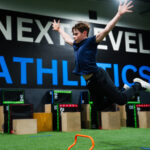Speed and Agility Training for Beginners
Starting something new can feel overwhelming. If you’re new to fitness or sports, learning how to move fast and with control might sound tough. But it doesn’t have to be.
This guide makes speed and agility training easy to understand — and even easier to begin.
Whether you’re a young athlete, a parent, or someone looking to get active, you’ll find everything you need to build a strong movement foundation.
What Is Speed and Agility Training?
Speed means how fast you can move. Agility means how quickly you can change direction.
Together, they help you:
-
Run faster
-
Move with control
-
React quickly
-
Stay balanced and injury-free
These skills are useful in almost every sport — and everyday life too.
The best part? You don’t need fancy equipment or hours in the gym to improve them.
Why Beginners Should Train Speed and Agility
If you’re just getting started with sports or exercise, speed and agility training can:
-
Build confidence
-
Improve coordination
-
Boost heart health
-
Make other workouts easier
-
Help prevent injuries
You’ll feel quicker, sharper, and more in control of your body.
Start Slow and Focus on Form
When you’re new, it’s not about going fast right away. It’s about learning how to move the right way.
Focus on:
-
Staying low in an athletic stance
-
Keeping your knees soft and chest up
-
Landing softly when jumping
-
Moving with control, not just speed
Taking your time helps build safe habits.
Warm Up First
Always warm up before speed and agility drills. Cold muscles can get hurt easily.
Do a 5- to 10-minute warm-up like this:
-
March in place
-
Arm circles
-
High knees
-
Butt kicks
-
Light jumping jacks
This gets your body ready to move and lowers your injury risk.
Easy Drills to Start With
You don’t need a coach or gym to start training. Try these beginner-friendly drills anywhere with a little space.
1. Line Hops
Draw a line on the ground or use tape.
-
Hop side-to-side for 15 seconds
-
Rest 30 seconds
-
Repeat 3 rounds
This boosts foot speed and balance.
2. High Knee Marches
Stand tall and drive your knees up one at a time.
-
Swing your arms
-
Keep your core tight
-
March for 20 steps
-
Rest and repeat 3 times
Great for building rhythm and power.
3. Cone Shuffles
Place 2 objects (like cones or water bottles) 5 feet apart.
-
Start at one cone
-
Shuffle to the other cone and back
-
Stay low with your chest up
-
Repeat for 20 seconds
-
Do 3–4 rounds
This helps with lateral movement and body control.
4. Quick Step-Ups
Find a low step or sturdy box.
-
Step up with one foot, then down
-
Go as fast as you can with control
-
Switch legs halfway through
-
Do 20 seconds, rest, and repeat 3 times
Improves leg power and cardio.
5. Tuck Jumps
Only do this if your knees feel good.
-
Jump straight up
-
Bring your knees toward your chest
-
Land softly
-
Do 5–8 jumps with good form
-
Rest and repeat for 3 sets
Tuck jumps build quickness and strength.
Make It a Weekly Plan
Here’s a sample beginner schedule using these drills:
Monday – Quick Feet + Control
-
Warm-up
-
Line hops (3 rounds)
-
High knee marches (3 rounds)
-
Step-ups (3 rounds)
-
Cool down
Wednesday – Lateral Agility
-
Warm-up
-
Cone shuffles (4 rounds)
-
Quick step-ups (3 rounds)
-
Core hold (plank for 20 seconds x 2)
-
Cool down
Friday – Jump Power + Reaction
-
Warm-up
-
Tuck jumps (3 sets of 5)
-
Line hops (3 rounds)
-
High knees (2 rounds)
-
Cool down
Start slow and stay consistent. Improvement comes with time.
Track Progress With Simple Metrics
You don’t need a stopwatch to measure success. Instead, focus on:
-
Moving with better balance
-
Feeling quicker off the ground
-
Less rest needed between rounds
-
Smoother transitions between drills
If you want more data, count reps or time your drills weekly.
Tips for Beginners to Stay Safe
Safety comes first — especially when starting out. Keep these tips in mind:
-
Use soft shoes with grip
-
Avoid slick or hard floors
-
Don’t push through pain
-
Rest between sets
-
Drink water often
According to Healthline, starting slow and using proper form is the best way to stay injury-free and motivated.
Build Confidence With Consistency
You don’t need to be perfect. What matters most is showing up and doing your best. The more you practice, the faster and smoother you’ll move.
Speed and agility training should feel fun and empowering. Once your body learns the movements, your confidence will grow in everything you do — on the field and off.
Next Level Support for New Athletes
At Next Level Athletics USA, we work with beginners every day. Our programs teach movement in a safe, simple way that builds confidence fast. Whether you’re just starting or want to get better for sports, we’re here to help you grow.
Conclusion
You don’t need to be fast to start. But you do need to start to get fast.
With easy drills, a little space, and a bit of consistency, you can improve your speed and agility from day one. The journey begins with simple steps, done with intention.
Stick with it, and you’ll be surprised how far your movement can go.


Recent Comments